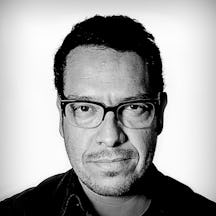A violent sexual assault left Lucia Osborne-Crowley overwhelmed with shame. After a decade of suffocating silence, Lucia is now determined to talk about what happened to her and to explore the impact shame has had on her life. By understanding shame’s power, she hopes to loosen its grip.
Shame’s long shadow
Words by Lucia Osborne-Crowleyartwork by Eduardo Rubioaverage reading time 5 minutes
- Serial

Shame is one of our strongest, most visceral emotions. Despite this – or perhaps because of it – we are often too afraid to examine and understand it. As a result, it has the power to wreak havoc on body and mind.
Shame has defined me more than any other emotion. Sometimes I think it is all I am. One of the main reasons that shame was able to take root, was able to grow and spread until I finally controlled it, is that I was never able to talk about what it was doing to me. If I’d understood more about shame earlier, I would be a very different person today.
A shameless act
When I was 15 years old I was raped by a grown man with a knife.
I was out with friends in my hometown of Sydney, Australia on a Saturday night. We were getting McDonald’s after a night of singing karaoke – mostly break-up songs about the teenage boys we believed had wronged us.
As we stood outside the McDonald’s, a group of men approached us. While the others were distracting my friends, one of the men took my hand forcefully and led me away. Suddenly everything inside me was frozen.
He locked me in a bathroom stall and raped me while holding a knife to my throat. I thought he was going to kill me. Sometimes in the years that followed, as the shame licked at my heels, I remember wishing he had.
But I didn’t ask for help. I didn’t ask for painkillers. I didn’t ask for comfort, or care, or love, or safety. I didn’t see a doctor. I didn’t go to the police. I didn’t tell my friends. I didn’t tell my parents. I didn’t even tell myself.
In fact, when I got back to my family home that night, I crept in the side door so my parents wouldn’t notice me come in. I was bleeding down my legs and I didn’t want them to see. I snuck into the bathroom attached to my bedroom and ran the shower. I sat underneath its heavy jets for what felt like hours. I scrubbed myself clean.
In her memoir about sexual abuse author Meera Atkinson writes: “Shame is often transmitted, paradoxically, by shameless acts, acts in which one person’s avoidance of shame demands another carry it.”
I carried the shame of an unrepentant, faceless man for ten years, all by myself.
Time slows down, the heart speeds up
Shame is triggered by different things depending on who we are, but we all experience it.
When we are plunged into shame, a few different things happen. Our major sweat glands tingle and become overactive. Our mouths dry up. We may feel light-headed and dizzy. We get a sense of ‘tunnel vision’ – the feeling that we can only see what is immediately in front of us. Time slows down. The heart speeds up.
The brain stands still, quite literally. Shame shuts down our prefrontal cortex, which is responsible for rational thought. The animal brain takes over.
Blood is redirected to our major muscle groups – the legs, the arms – getting us ready to run. As the heart races and blood pressure rises, we become overwhelmed by the emotional pain that also comes with shame. It is a piercing, distressing feeling.
A powerful urge to escape
Scientists, theologists and psychoanalysts agree on a basic definition of shame as both a physical and emotional experience. It is the sense that we are fundamentally bad or unworthy; that our very being has been poisoned by something toxic and immutable. Something rotten. It is a feeling that calcifies every part of our lives.
The philosopher Jean-Paul Sartre described shame as that “immediate shudder that runs through me from head to foot”. Because it is so potent, and because we don’t speak openly about it, too often we don’t even recognise shame for what it is. Psychologist Jonathon Tomlinson explains, “Shame isn’t usually experienced as shame – it is an emotional response including fear, anxiety, and a powerful urge to escape.”
It is the sense that we are fundamentally bad or unworthy; that our very being has been poisoned by something toxic and immutable.
I am only just beginning to recover from the damage done to me by shame, only just beginning to cobble together a life that is not defined by a pervasive sense of worthlessness. I wish I had known earlier just how dangerous shame can be. Just how much it can hurt us when it is left unchecked.
Silence is the oxygen of shame. It needs it to survive. Shame itself is like water: it has the power to drown us. I am determined to fight shame by talking about it in all its complexity, and I’m convinced that if we all talk more honestly about it, we will learn to swim.
About the contributors
Lucia Osborne-Crowley
Lucia Osborne-Crowley is a writer and journalist. Her first book, ‘I Choose Elena’, was published in 2019. Her second book, ‘My Body Keeps Your Secrets’, will be published in 2020. Her news reporting and literary work has appeared in Granta, GQ, the Sunday Times, HuffPost UK, the Guardian, ABC News, Meanjin, The Lifted Brow and others.
Eduardo Rubio
Eduardo Rubio is a Mexican-born artist and illustrator living in Madrid. His work mainly involves collaboration with publishing houses and brands; he also works on personal projects, which he exhibits in galleries and museums.

